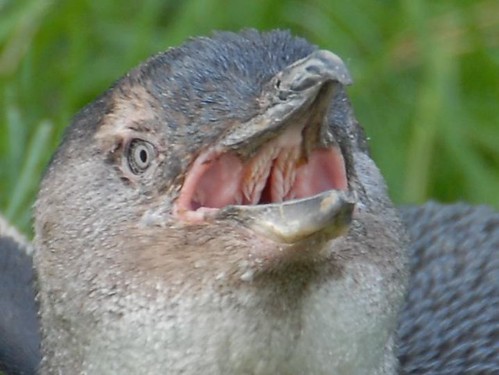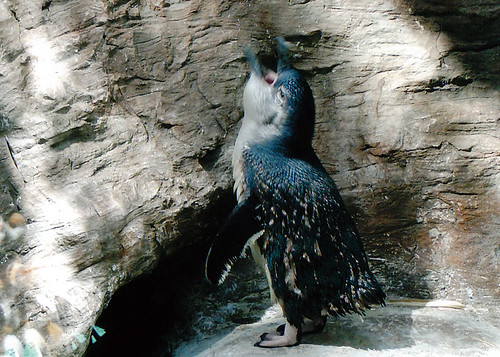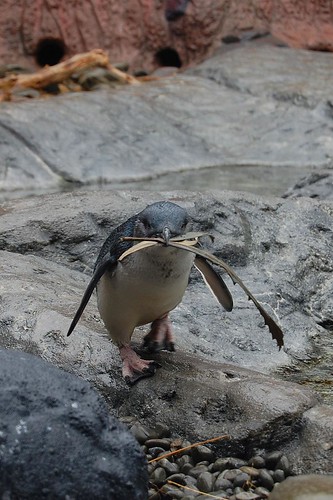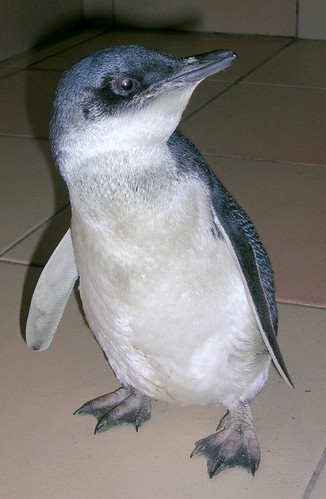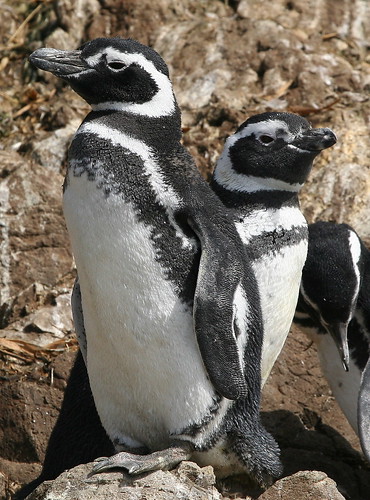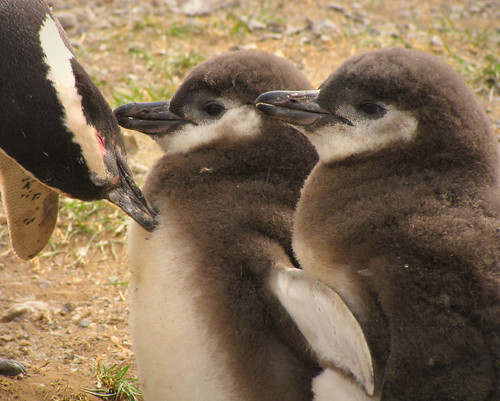wiinterrr
Adelie Penguins Fall Victim to Warming
Penguins' struggle is a warning to world
Adelies are early victims of a trend that could devastate coastlines
By William Mullen, The Chicago Tribune, July 1, 2007
CAPE ROYDS, Antarctica -- On a cloudy spring day, the first gray Adelie penguin chicks are hatching out in round pebble nests strewn across a bleak, rocky coastline, poking their heads from beneath the snowy-white shirt front of an adult for their first blinking look at the world.
The nests are barely a wingspan apart, and the adults, peevish and quarrelsome by nature, sit as to avoid looking directly at one another. The odd arrangement helps the penguins watch for predators that lurk nearby in hopes of snatching a chick or egg. They are Antarctic skuas, a brown bird similar to a gull.
"One pulls the tail of the incubating penguin parent, and as the penguin turns and lifts to fend the attacker off, the other skua pulls out the egg and runs," said Adelie researcher David Ainley. "It's best if you are a penguin to nest next to birds that will watch your back while you watch theirs."
These days, however, Adelies are being stalked by a threat they cannot see and cannot fight off: the weather. The birds, which have adapted over millions of years to the most extreme climate on Earth, are beginning to die off by the tens of thousands as a result of global warming.
The Adelie penguin is regarded as an "indicator" species, an animal so delicately attuned to its environment that its survival is threatened as soon as something goes wrong. So as temperatures rise, Adelies are among the first to feel the effects, early victims of the devastating worldwide changes that scientists expect if the warming persists and intensifies.
Because of Antarctica's key role in regulating the global climate, change there is not simply a faraway event in a frozen wilderness. The continent is an ice machine that, if broken, has the potential to release massive amounts of water into the oceans and disrupt the flow of chilled currents that shape the world's weather.
Today, floating ice formations that are crucial to the Adelies' survival are melting and thinning. Tomorrow, experts fear the thawing Antarctic ice sheets may raise sea levels around the world, swamping coastal areas that are home to millions of people.
Along the tip of the Antarctic Peninsula, which reaches farther north than anywhere else on the continent, average annual temperatures have risen 4.5 degrees in just the last 30 years. By comparison, the Earth's annual temperature has increased by 1.4 degrees in the last century.
In this vulnerable area, entire colonies of Adelie penguins have died because, researchers believe, the ice no longer extends far enough into the sea to allow the birds to reach their winter feeding grounds. Biologist William Fraser monitors a 50-square-mile area where 56,000 Adelies have perished.
"For our region I work in, the Adelies will be locally extinct within a decade," Fraser said. "One of the colonies we worked on for 30 years went extinct last year, from 1,000 breeding pairs to zero."
For now, such deaths represent a small fraction of the world's estimated 8 million to 10 million Adelie penguins, which live only on Antarctica. In fact, for many Adelie populations -- including the southern colony that Ainley is watching at Cape Royds -- warmer weather has actually made life a little easier for the time being. The higher temperatures have opened more breaks in the ice close to their nesting grounds, increasing access to open water. That makes it easier for parents to feed themselves and their offspring, and more chicks are making it to adulthood.
But the die-offs scientists are seeing in the warmest areas of Antarctica are expected to spread as temperatures continue to rise. If the warming continues, Ainley said, the Adelies ultimately will go extinct -- though it might take hundreds of years.
The reason is simple, he said: "Penguins don't see well in the dark."
Below the Antarctic Circle, the hours of sunlight shrink during winter until it is dark 24 hours a day. That is one key reason Adelie penguins migrate: They must travel far enough north so there is enough sunlight for a successful daily hunt. Otherwise, they will starve.
A warmer Antarctic climate may shrink the winter ice so much that it strands the birds too far south, in places where the sun doesn't rise, and the lights may go out permanently for the Adelies.
As Ainley succinctly summed up in his 2002 book "The Adelie Penguin: Bellwether of Climate Change": "Where there is no ice, there are no Adelie penguins."
When he first went to Antarctica to study penguins in 1968, Ainley's research interest was pure biology. But in the last 20 years or so, his research increasingly has had to deal with global warming as it begins to change the environment where the Adelies live.
Climate a growing factor
Indeed, climate change has crept into the work of scientists of virtually every stripe who work on the frozen continent -- biology, geology, paleontology, meteorology, glaciology. Belonging to no nation and having no permanent human population, Antarctica draws more than 4,000 scientists each year. The U.S. Antarctic Program spends more than $320 million annually on research there.
Ainley, an expert on sea birds and ocean environments, has made 28 trips to study Adelies in Antarctica and has been camping with the Cape Royds Adelies during their nesting season since the 1990s. Funded by the National Science Foundation, he had to abandon teaching because his field season from November to February is at the heart of the academic year.
A flinty New England native transplanted to California, Ainley is not a man of many words when one or two will do. Yet he is a tireless advocate for protecting the Earth's ecosystems, using his satellite phone in Cape Royds to lend support and advice to environmentalists all over the world and to deliver stinging rebukes to their foes.
At Cape Royds, where Ainley lives in a little hut a few hundred yards uphill from the Cape Royds colony, the work he does is typical of other ongoing projects on the continent. He uses a combination of old-school field observations and state-of-the-art technology to learn about the Adelies' past, present and future.
Because Antarctica has the world's harshest, most inhospitable environment, doing research there is often extraordinarily difficult. Adelie penguins spend barely three months on land. They live most of their lives traveling the high seas among enormous ice floes, a cold and dangerous journey that is impossible for humans to follow.
That means researchers such as Ainley can observe the Adelies only about a quarter of the year at best and mostly on land, leaving huge gaps in the knowledge of Adelie life cycles.
Where the Adelies actually go when they abandon land, and why, remained a mystery for a century, until Ainley and other researchers began to track their travels with new technology six years ago. What they learned had profound implications for the penguins' future.
Hallowed site for researchers
It's fitting this breakthrough occurred in part by studying the colony at Cape Royds, a bulge off the south end of Ross Island where the island butts up against the Ross Ice Shelf, which is frozen year-round.
Though relatively small, the colony is a hallowed site for penguin research. It was the subject of the first long-term field study of penguins anywhere, conducted a century ago by legendary explorer Ernest Shackleton and his crew.
Much of Ainley's work today consists of monitoring the progress of chicks he has banded on the left wing, about 400 each year, as they grow up. If they live a full life, he might see them for 15 years or more.
Adelie life at Cape Royds begins in late October -- early spring in Antarctica -- when the adults return to land from their long winter migrations, ready to nest, mate and raise penguin chicks.
Adult Adelies, who pair up for life, are roughly 28 inches tall and weigh about 12 pounds, depending on the season. Their backs, long tails, wings and faces are black, but their fronts are white and each eye has a distinctive white circle. Swift and agile in water, the short-legged birds waddle on land slightly faster than 1 m.p.h. at best.
The males are the first to arrive at the nesting ground, followed by the females four or five days later, who set about looking for their spouses and the nests the males have picked out. Each of the birds brays a unique identity call, which results in a tremendous din, like an arena full of Rocky Balboas and Adrians shouting for each other.
Ainley knows penguins have been doing this at Cape Royds for at least 900 years from radiocarbon dating done on flattened, dried-out Adelie bodies that litter the nesting grounds. It so rarely and briefly gets warmer than freezing at the cape that old carcasses never rot.
The couples collect small stones and build up their nests, often fighting with thieving neighbors who steal their rocks. Once the nest is complete, the female soon lays one or two eggs, and the males take the first turn at incubation, waiting on the nest for several weeks while the females go off to feed.
Curious about these hunts, Ainley recently fenced off about 150 nests and attached tiny transponders to the adults. To enter or leave the enclosure, a bird had to cross a "weigh bridge" with a scale and a sensor attuned to the transponders. By comparing departure weight to arrival weight, he found out how much food it had foraged.
After the eggs hatch, much of the foraged food is regurgitated into the gullets of the chicks. Within two or three weeks of hatching, the chicks are nearly adult size, big enough to fend off the predatory skuas but so hungry that both parents must go hunting to feed them.
At about 9 weeks, the chicks begin to hunt on their own, said Ainley. "The chicks are wide-eyed and bushy-tailed, and go off to see the world. They get curious and have the urge to travel, and they seem to recognize the ocean as their destination."
The treacherous journey
The chicks grow up just in time. In late January, as the summer sunshine rapidly declines at Cape Royds, the penguins must begin their annual migration. The journey, through extremely treacherous weather and seas, is surely one of the most perilous migrations of any bird species.
Led by experienced members, this exodus occurs at every Adelie colony all around Antarctica, and the birds do not return to land until nine months later.
To flee the winter darkness, the penguins rely on the Antarctic pack ice, a seasonal phenomenon that grows outward in every direction from mainland Antarctica, extending from the shore like a vast shelf. By July, the ice reaches as far as 1,000 miles into the Southern Sea, temporarily doubling Antarctica's 5.4 million square miles.
Although penguins can travel much faster by swimming than by traversing the ice, they can swim for only a couple of hours at a time before growing exhausted. The birds rest on the floes, huddling together at night.
But the pack ice is foe as well as friend to the Adelies. If the birds do not keep moving, the pack ice will cut off their access to open water as it freezes up solidly behind them, preventing the penguins from hunting for food.
From ships leaving Antarctica for the winter, scientists have seen Adelies waddle, slide and toboggan on their bellies across huge tippy ice floes in heaving seas. When the birds reach the edge of the ice, they speed like torpedoes through the water, then propel themselves into the air to land on the next floe.
The penguins aim their route toward natural breaks in the ice called polynyas, formed by slightly warmer deep currents welling up from the depths. There, the Adelies know, they can hunt their prey, mostly Antarctic silverfish and krill, a tiny shrimplike animal.
"They aren't simply drifting randomly with the ice," said Fraser. "They're moving with a purpose, hopscotching across the ice to seek areas of high prey availability, which doesn't occur just anywhere, but in specific regions."
Researchers have never been able to follow the Adelies on the winter migration. But six years ago, Ainley and biologists at other colonies began attaching small leg-band sensors to some of the birds before their departure. When the penguins returned to nest, the researchers downloaded the information.
From sunlight readings taken every 60 seconds, scientists were able to figure out how far north the penguins had traveled. At the height of winter, the Cape Royds Adelies were several hundred miles north of the Antarctic Circle, or about 1,000 miles north of their nesting grounds.
"We were a little surprised," said Ainley. "We didn't know they traveled that far."
The finding brought into focus the fate that awaits the Adelies if global warming turns off their winter sunlight.
Shifts at the poles
Temperatures are rising worldwide, but the warming has been more severe in the Arctic and Antarctic, in part because the atmosphere is thinner at the Earth's polar ends.
In the Arctic north, the extent of the winter pack ice has shrunk by 20 percent in the last 50 years, and its average thickness has thinned by 50 percent. By 2100 -- when a United Nations panel predicts the planet's average temperature will have risen between 3.2 and 7.1 degrees Fahrenheit -- all of it may be gone.
At the other end of the world, the Antarctic pack ice has not been so severely disrupted. But in West Antarctica, where warming has been greatest, the ice has begun to shrink.
As it does, more than just penguins are at stake.
"The dangers of losing sea ice cover in the southern latitudes of the Southern Ocean is that the unique community associated with that cover would disappear," said Ainley. "The krill, fish, penguins and seals, the whole works. They'd be replaced by marine critters from the [warmer] sub-Antarctic."
In fact, the northern half of the Antarctic Peninsula already is undergoing that transformation, with plants and animals that cannot tolerate extreme cold and ice migrating to the area as it warms up.
Grasses not seen on the peninsula since humans arrived 200 years ago are now growing luxuriantly in northern areas. Chinstrap and Gentoo penguins, which don't rely on sea ice in their life cycle, are colonizing the peninsula.
As those species move in, the Adelies are disappearing. In the area Fraser studies -- the vicinity of the U.S. Palmer Research Station, along the coast of the Antarctic Peninsula -- tens of thousands of penguins have failed to return from their winter voyages, leading Fraser to suspect the birds cannot reach the food-rich areas they usually visit.
"Adelie populations where we work have decreased by 80 percent over the last 30 years," said Fraser. "We're at a point that of the 56 active colonies we work with, 80 percent of them are no longer numerically viable; they have too few pairs to sustain them."
Temporary benefits
For the moment, the situation is different for Ainley's penguins at Cape Royds, 2,400 miles away. The colony nests farther south than any other penguins in the world, and in this harsh environment a little extra warmth is, temporarily, welcome.
So far, global warming does not seem to have affected their winter migration, perhaps because area temperatures have not risen as much as they have along the peninsula. And thanks to new breaks in the ice near their nesting grounds, Adelie parents are finding it easier to hunt. More of their chicks are surviving, leading to a population boom.
"Right now global warming is doing great things for penguins in the Ross Sea," said Ainley. "Adelie penguins now probably are more abundant, continent-wide, than they've been for 3,000 years."
But the good times cannot last if the pack ice melts away, even at Cape Royds. Ultimately, the species will be trapped in places where it cannot survive the 24-hour darkness of winter.
"That's the nightmare scenario for Adelie penguins," Fraser said. "Below the Antarctic Circle, you begin to lose light very, very quickly. And unfortunately it's looking like a realistic scenario: the continuing disappearance of sea ice until there is no winter habitat left for them. They would go extinct."
The struggles of the Adelies and other Antarctic species may seem remote, but experts say they are signals not to be ignored.
They note that although Antarctica has always gone through warmer and colder cycles, with retreating and advancing ice formations, the speed of the warm-up in the last half-century seems to set this era apart.
"The rate of change is accelerating at an unprecedented rate," said Ainley, "at least in the context of the last few thousands or tens of thousands of years."
The global significance of that change is the reason so much scientific firepower is being focused on Antarctica, from biologists watching how warming affects penguin colonies to geologists documenting deterioration of the massive ice sheets that cover the western continent.
"Climate change is very serious stuff, and that's the message Adelie penguins have been telling us," Ainley said. "Humans have to learn lessons from what these penguins are going through."
Iceberg was an early test for Adelies
Seven years ago, the largest iceberg in recorded history broke off Antarctica's Ross Ice Shelf, a chunk of ice slightly larger than the island of Jamaica. For the Adelie penguins of Cape Royds, the iceberg soon would present a test of their ability to adapt to a changed environment.
After calving from the shelf, the iceberg broke in two and the larger piece slowly floated hundreds of miles west, reaching Cape Royds in early 2001. It lodged itself on the sea floor just north of the cape, next to a smaller chunk of ice that had arrived earlier.
The Adelie colony had just left on its annual nine-month winter migration. When the birds returned for the breeding season in October, they found their way blocked by the icebergs while still far out at sea. To get to their nesting ground, the penguins had to walk 50 miles or more around the bergs on jammed-up sea ice.
Slow and clumsy on their feet, the birds arrived exhausted, said biologist David Ainley. When the females left the nests to seek food in open water, leaving the males to incubate the eggs, they had to traverse the 50 miles all over again.
"The females walked out and never came back," said Ainley. "They didn't want to make the trip again."
The males stayed with the eggs for weeks, he said, "but when their mates never returned to relieve them, they finally got so hungry they ... abandoned the eggs in the nests."
The icebergs remained for four years before floating off, giving Ainley a chance to observe how the penguins reacted in subsequent breeding seasons.
Older Adelie pairs, he found, stubbornly kept returning to familiar ground even though fewer chicks hatched because of the difficult conditions. The colony, which had 4,000 breeding pairs in 2002 and was one of the fastest growing in Antarctica, now has barely half that number.
But many younger penguins abandoned Royds to join colonies miles away that were not blocked by the icebergs.
Ainley said he sees a lesson in this for the future. If global warming melts the ice around the Adelies' traditional territories so severely that it can no longer support them, some will simply perish.
But young pairs may head south, finding new territories in places that used to be too cold for penguins. That, Ainley said, may extend the species' survival -- at least for a time.
Story courtesy of "The Heat is On" @
http://www.heatisonline.org/contentserver/objecthandlers/index.cfm?ID=6503&Method=Full




